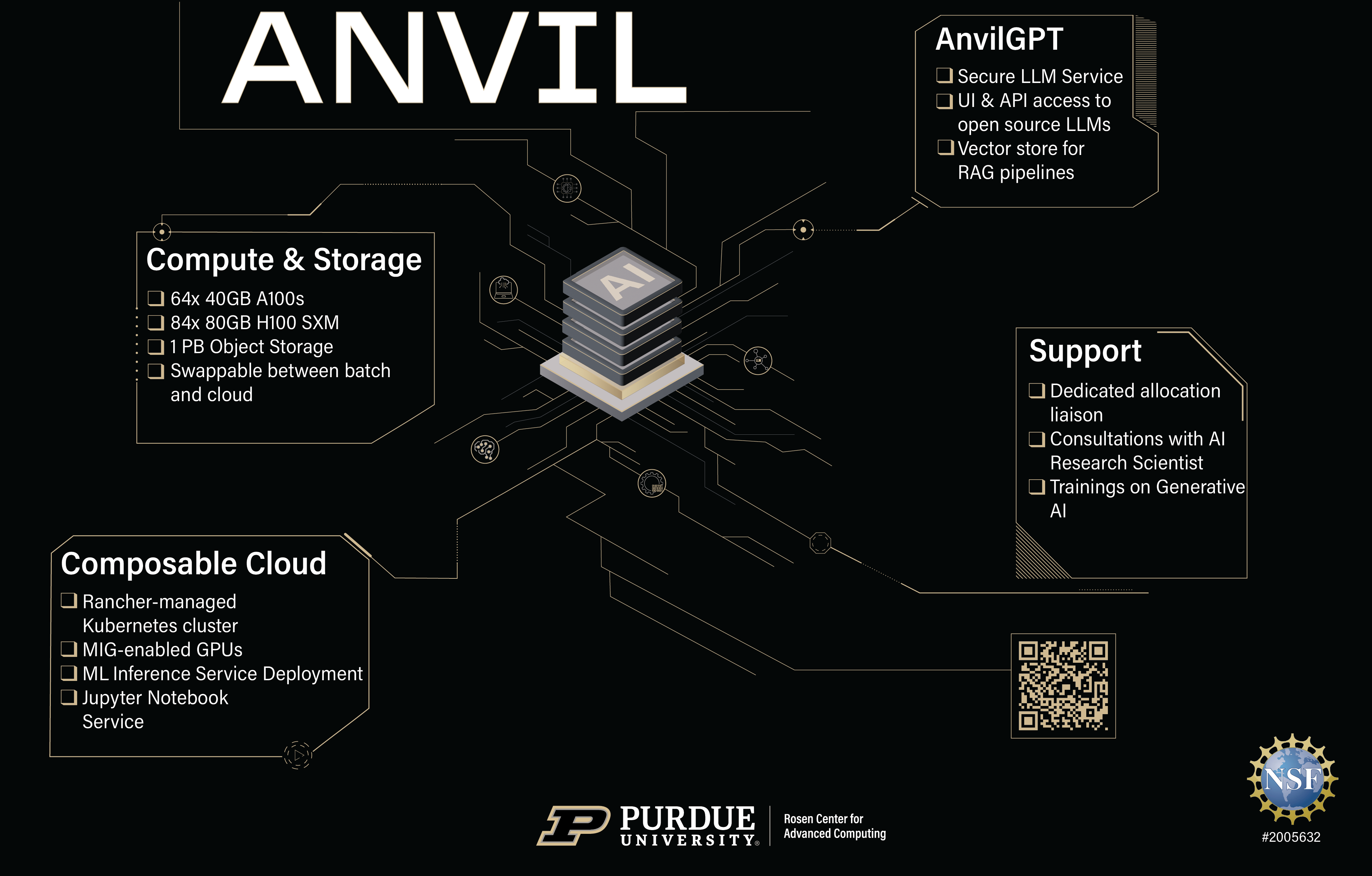Anvil AI hardware has arrived
Purdue University’s powerful supercomputer, Anvil, recently received a major upgrade, thanks to funding provided by the National Science Foundation’s (NSF) NAIRR Pilot Program. The new expansion has been installed and is now ready for use. With this Anvil upgrade, Purdue now offers a national supercomputing resource designed to enhance artificial intelligence (AI) workflows and help the U.S. lead the charge in AI research.
Earlier this year,  the NSF launched the National Artificial Intelligence Research Resource (NAIRR) Pilot to demonstrate the NAIRR concept and advance its primary goals of spurring innovation, increasing diversity of talent, improving capacity, and advancing safe, secure, and trustworthy AI in research and society. As an official resource provider for the NAIRR Pilot, Anvil received funding to pursue these goals, namely by improving Anvil’s capacity to enable AI research. A total of 84 Nvidia H100 SXM GPUs were procured and added to the system. With this upgrade, Anvil is now poised to deliver a world-class AI supercomputing resource to researchers nationwide.
the NSF launched the National Artificial Intelligence Research Resource (NAIRR) Pilot to demonstrate the NAIRR concept and advance its primary goals of spurring innovation, increasing diversity of talent, improving capacity, and advancing safe, secure, and trustworthy AI in research and society. As an official resource provider for the NAIRR Pilot, Anvil received funding to pursue these goals, namely by improving Anvil’s capacity to enable AI research. A total of 84 Nvidia H100 SXM GPUs were procured and added to the system. With this upgrade, Anvil is now poised to deliver a world-class AI supercomputing resource to researchers nationwide.
Before the expansion, Anvil’s system consisted of 1,000 Dell compute nodes, each with two 64-core third-generation AMD EPYC processors, 32 large memory nodes with 1 TB of RAM per node, and 16 GPU nodes, each with four NVIDIA A100 Tensor Core GPUs, all of which are interconnected with 100 Gbps Nvidia Quantum HDR Infiniband. The new NSF funding has added 21 Dell PowerEdge XE9640 compute nodes, each with 4 Nvidia 80GB H100 SXM GPUs, as well as an additional 1 PB of flash-based object storage integrated into Anvil’s composable subsystem. The new GPU nodes also feature an additional NDR Infiniband fabric to support larger AI workloads.
“Anvil joined the NAIRR Pilot as a resource provider in May this year,” says Rosen Center Chief Scientist Carol Song, principal investigator and project director for Anvil. “We made available Anvil’s discretionary capacity, which was allocated entirely to researchers, right away. This H100 GPU expansion not only gives Anvil a significant boost to the amount of resources available to the NAIRR Pilot users, but also provides a major increase in Anvil’s GPU computing power. The H100 GPU outperforms the current A100 GPU in Anvil by as much as nine times in computing speed. Many workloads, especially AI model training and inference, will run much faster, reducing the time-to-results for researchers.”
The new nodes will also allow Anvil to further enhance its world-class outreach and training capabilities and initiatives, as well as enable dedicated AI expert support for AI researchers. In preparation for the expansion, the Anvil team has been focusing on how to quickly and efficiently get NAIRR researchers onto Anvil.
Researchers and educators can apply for access to NAIRR resources and view descriptions of the first cohort projects at https://nairrpilot.org/. Resource request submissions can be made following the process outlined in https://nairrpilot.org/opportunities/allocations. Submissions should select “Purdue Anvil CPU” or “Purdue Anvil GPU” as the preferred resource, depending on the user’s needs. Anyone with questions should contact anvil@purdue.edu.
More information about Anvil is available on Purdue’s Anvil website. Anvil is funded under NSF award No. 2005632.
Written by: Jonathan Poole, poole43@purdue.edu
